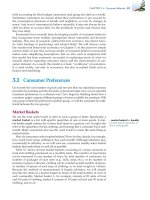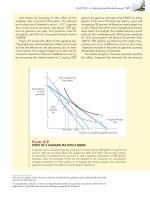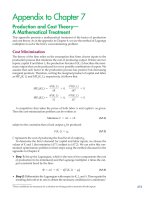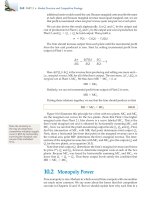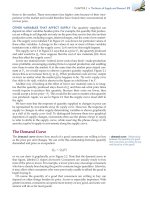(8th edition) (the pearson series in economics) robert pindyck, daniel rubinfeld microecon 452
Bạn đang xem bản rút gọn của tài liệu. Xem và tải ngay bản đầy đủ của tài liệu tại đây (136.49 KB, 1 trang )
CHAPTER 11 • Pricing with Market Power 427
r2
PB
III—Buy
Only
Good 2
F IGURE 11.19
MIXED BUNDLING IN PRACTICE
II—Buy
Bundle
P2
I—Buy
Nothing
IV—Buy
Only Good 1
P1
PB
The dots in this figure are estimates of reservation prices
for a representative sample of consumers. A company could
first choose a price for the bundle, PB, such that a diagonal
line connecting these prices passes roughly midway through
the dots. The company could then try individual prices P1
and P2. Given P1, P2, and PB, profits can be calculated for
this sample of consumers. Managers can then raise or lower P1, P2, and PB and see whether the new pricing leads to
higher profits. This procedure is repeated until total profit is
roughly maximized.
r1
can then raise or lower P1, P2, and PB and see whether doing so leads to higher
profits. This can be done repeatedly (on a computer) until prices are found that
roughly maximize total profit.
EX AMPLE 11. 5
THE COMPLETE DINNER VERSUS À LA CARTE:
A RESTAURANT’S PRICING PROBLEM
Many restaurants offer both complete dinners and à la carte menus.
Why? Most customers go out to
eat knowing roughly how much
they are willing to spend for dinner
(and choose the restaurant accordingly). Diners, however, have different preferences. For example,
some value appetizers highly but
could happily skip dessert. Others
attach little value to the appetizer but regard dessert
as essential. And some customers attach moderate
values to both appetizers and desserts. What pricing strategy lets the restaurant capture as much consumer surplus as possible from these heterogeneous
customers? The answer, of course, is mixed bundling.
For a restaurant, mixed bundling means offering
both complete dinners (the appetizer, main course,
and dessert come as a package) and an à la carte menu
(the customer buys the appetizer,
main course, and dessert separately). This strategy allows the à la
carte menu to be priced to capture
consumer surplus from customers who value some dishes much
more highly than others. (Such customers would correspond to consumers A and D in Figure 11.17
(page 424).) At the same time, the
complete dinner retains those customers who have
lower variations in their reservation prices for different
dishes (e.g., customers who attach moderate values
to both appetizers and desserts).
For example, if the restaurant expects to attract
customers willing to spend about $20 for dinner, it
might charge about $5 for appetizers, $14 for a typical main dish, and $4 for dessert. It could also offer
a complete dinner, which includes an appetizer,

